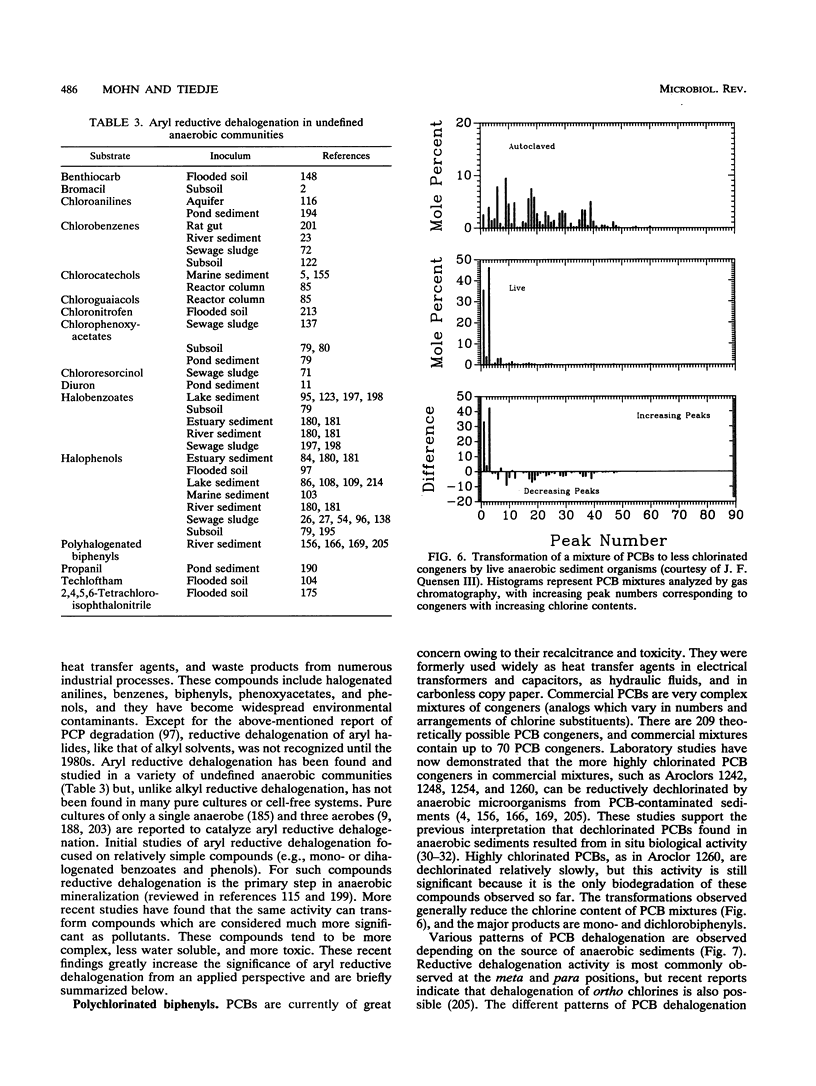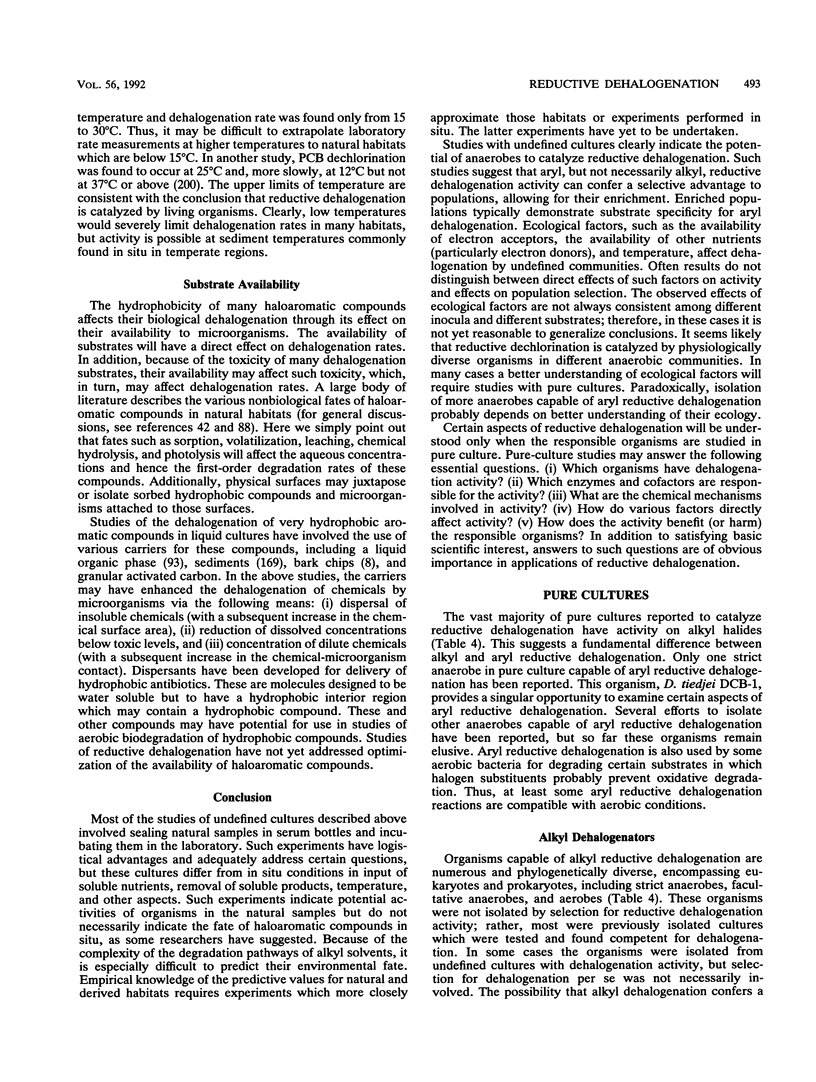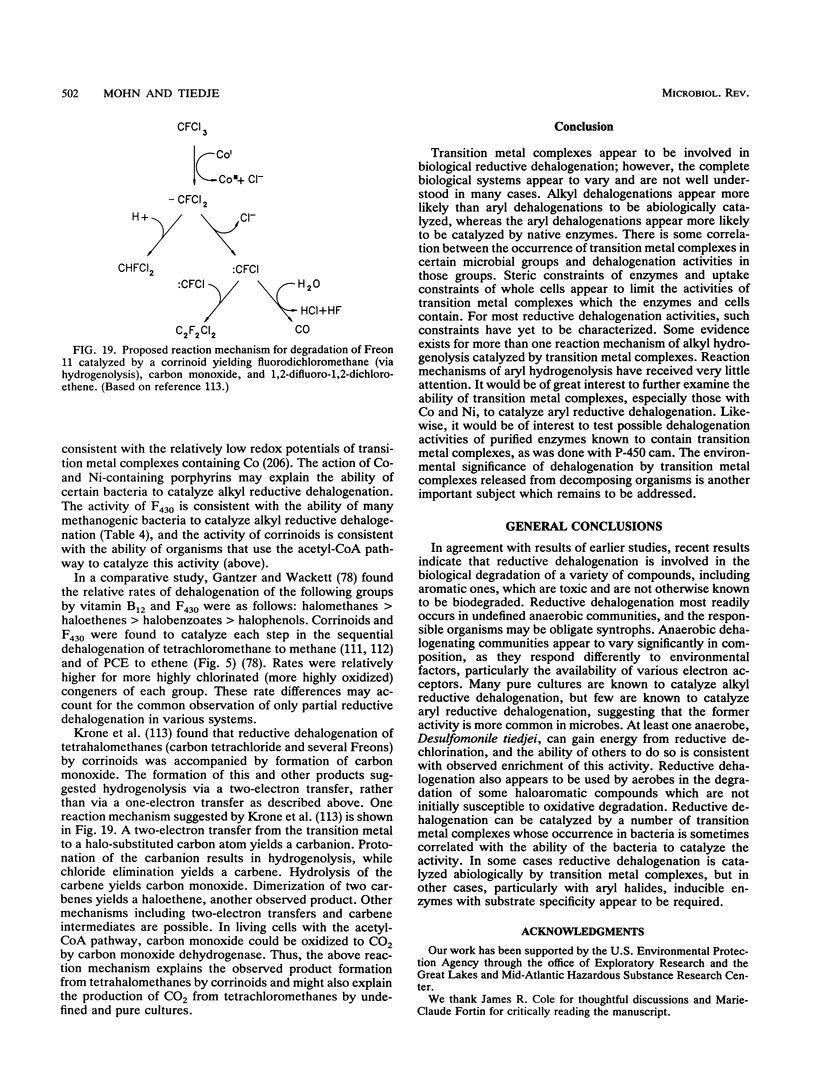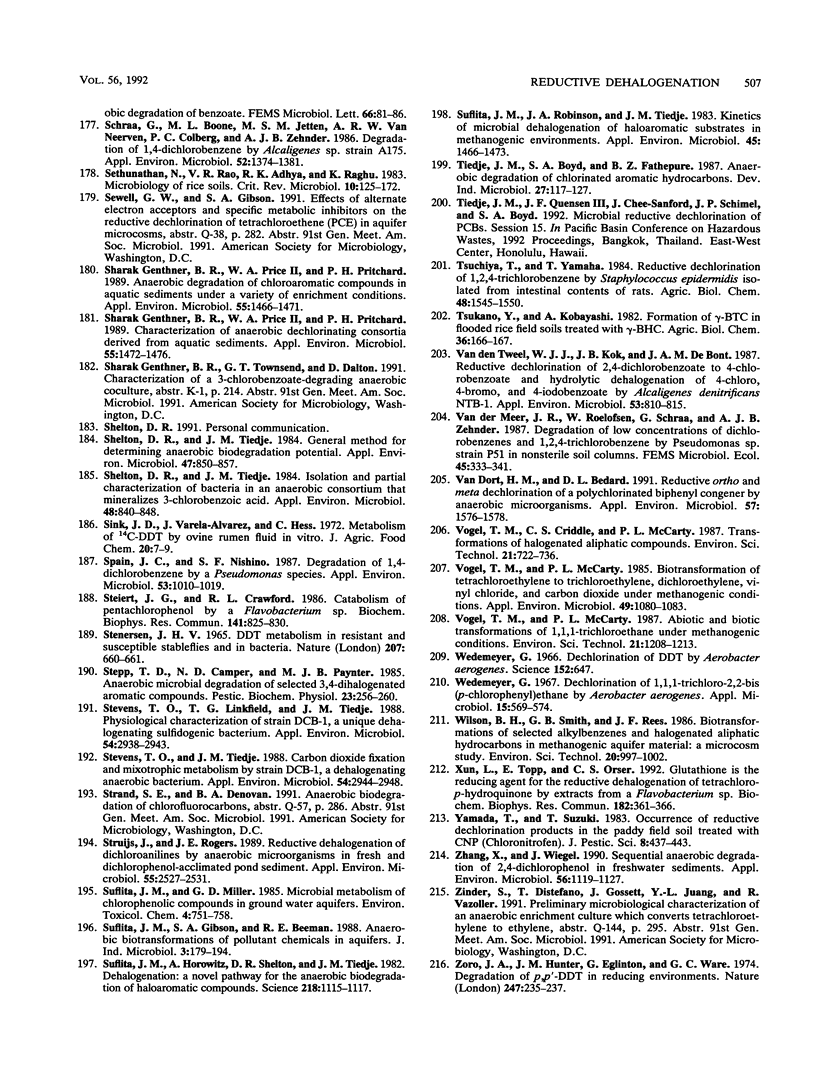Abstract
A wide variety of compounds can be biodegraded via reductive removal of halogen substituents. This process can degrade toxic pollutants, some of which are not known to be biodegraded by any other means. Reductive dehalogenation of aromatic compounds has been found primarily in undefined, syntrophic anaerobic communities. We discuss ecological and physiological principles which appear to be important in these communities and evaluate how widely applicable these principles are. Anaerobic communities that catalyze reductive dehalogenation appear to differ in many respects. A large number of pure cultures which catalyze reductive dehalogenation of aliphatic compounds are known, in contrast to only a few organisms which catalyze reductive dehalogenation of aromatic compounds. Desulfomonile tiedjei DCB-1 is an anaerobe which dehalogenates aromatic compounds and is physiologically and morphologically unusual in a number of respects, including the ability to exploit reductive dehalogenation for energy metabolism. When possible, we use D. tiedjei as a model to understand dehalogenating organisms in the above-mentioned undefined systems. Aerobes use reductive dehalogenation for substrates which are resistant to known mechanisms of oxidative attack. Reductive dehalogenation, especially of aliphatic compounds, has recently been found in cell-free systems. These systems give us an insight into how and why microorganisms catalyze this activity. In some cases transition metal complexes serve as catalysts, whereas in other cases, particularly with aromatic substrates, the catalysts appear to be enzymes.
Full text
PDF

























Images in this article
Selected References
These references are in PubMed. This may not be the complete list of references from this article.
- Adrian N. R., Suflita J. M. Reductive dehalogenation of a nitrogen heterocyclic herbicide in anoxic aquifer slurries. Appl Environ Microbiol. 1990 Jan;56(1):292–294. doi: 10.1128/aem.56.1.292-294.1990. [DOI] [PMC free article] [PubMed] [Google Scholar]
- Allard A. S., Hynning P. A., Lindgren C., Remberger M., Neilson A. H. Dechlorination of chlorocatechols by stable enrichment cultures of anaerobic bacteria. Appl Environ Microbiol. 1991 Jan;57(1):77–84. doi: 10.1128/aem.57.1.77-84.1991. [DOI] [PMC free article] [PubMed] [Google Scholar]
- Andrade P. S., Jr, Wheeler W. B. Biodegradation of mirex by sewage sludge organisms. Bull Environ Contam Toxicol. 1974 May;11(5):415–416. doi: 10.1007/BF01685296. [DOI] [PubMed] [Google Scholar]
- Apajalahti J. H., Salkinoja-Salonen M. S. Complete dechlorination of tetrachlorohydroquinone by cell extracts of pentachlorophenol-induced Rhodococcus chlorophenolicus. J Bacteriol. 1987 Nov;169(11):5125–5130. doi: 10.1128/jb.169.11.5125-5130.1987. [DOI] [PMC free article] [PubMed] [Google Scholar]
- Attaway H. H., 3rd, Paynter M. J., Camper N. D. Degradation of selected phenylurea herbicides by anaerobic pond sediment. J Environ Sci Health B. 1982;17(6):683–699. doi: 10.1080/03601238209372350. [DOI] [PubMed] [Google Scholar]
- Bagley D. M., Gossett J. M. Tetrachloroethene transformation to trichloroethene and cis-1,2-dichloroethene by sulfate-reducing enrichment cultures. Appl Environ Microbiol. 1990 Aug;56(8):2511–2516. doi: 10.1128/aem.56.8.2511-2516.1990. [DOI] [PMC free article] [PubMed] [Google Scholar]
- Belay N., Daniels L. Production of ethane, ethylene, and acetylene from halogenated hydrocarbons by methanogenic bacteria. Appl Environ Microbiol. 1987 Jul;53(7):1604–1610. doi: 10.1128/aem.53.7.1604-1610.1987. [DOI] [PMC free article] [PubMed] [Google Scholar]
- Berry D. F., Francis A. J., Bollag J. M. Microbial metabolism of homocyclic and heterocyclic aromatic compounds under anaerobic conditions. Microbiol Rev. 1987 Mar;51(1):43–59. doi: 10.1128/mr.51.1.43-59.1987. [DOI] [PMC free article] [PubMed] [Google Scholar]
- Bouwer E. J., McCarty P. L. Transformations of 1- and 2-carbon halogenated aliphatic organic compounds under methanogenic conditions. Appl Environ Microbiol. 1983 Apr;45(4):1286–1294. doi: 10.1128/aem.45.4.1286-1294.1983. [DOI] [PMC free article] [PubMed] [Google Scholar]
- Bouwer E. J., McCarty P. L. Transformations of halogenated organic compounds under denitrification conditions. Appl Environ Microbiol. 1983 Apr;45(4):1295–1299. doi: 10.1128/aem.45.4.1295-1299.1983. [DOI] [PMC free article] [PubMed] [Google Scholar]
- Boyd S. A., Shelton D. R. Anaerobic biodegradation of chlorophenols in fresh and acclimated sludge. Appl Environ Microbiol. 1984 Feb;47(2):272–277. doi: 10.1128/aem.47.2.272-277.1984. [DOI] [PMC free article] [PubMed] [Google Scholar]
- Boyd S. A., Shelton D. R., Berry D., Tiedje J. M. Anaerobic biodegradation of phenolic compounds in digested sludge. Appl Environ Microbiol. 1983 Jul;46(1):50–54. doi: 10.1128/aem.46.1.50-54.1983. [DOI] [PMC free article] [PubMed] [Google Scholar]
- Brown J. F., Jr, Bedard D. L., Brennan M. J., Carnahan J. C., Feng H., Wagner R. E. Polychlorinated biphenyl dechlorination in aquatic sediments. Science. 1987 May 8;236(4802):709–712. doi: 10.1126/science.236.4802.709. [DOI] [PubMed] [Google Scholar]
- Bryant F. O., Hale D. D., Rogers J. E. Regiospecific dechlorination of pentachlorophenol by dichlorophenol-adapted microorganisms in freshwater, anaerobic sediment slurries. Appl Environ Microbiol. 1991 Aug;57(8):2293–2301. doi: 10.1128/aem.57.8.2293-2301.1991. [DOI] [PMC free article] [PubMed] [Google Scholar]
- Burge W. D. Anaerobic decomposition of DDT in soil. Acceleration by volatile components of alfalfa. J Agric Food Chem. 1971 Mar-Apr;19(2):375–378. doi: 10.1021/jf60174a031. [DOI] [PubMed] [Google Scholar]
- Castro C. E., Wade R. S., Belser N. O. Biodehalogenation: reactions of cytochrome P-450 with polyhalomethanes. Biochemistry. 1985 Jan 1;24(1):204–210. doi: 10.1021/bi00322a029. [DOI] [PubMed] [Google Scholar]
- Castro T. F., Yoshida T. Degradation of organochlorine insecticides in flooded soils in the Philippines. J Agric Food Chem. 1971 Nov-Dec;19(6):1168–1170. doi: 10.1021/jf60178a041. [DOI] [PubMed] [Google Scholar]
- Chacke C. I., Lockwood J. L., Zabik M. Chlorinated hydrocarbon pesticides: degradation by microbes. Science. 1966 Nov 18;154(3751):893–895. doi: 10.1126/science.154.3751.893. [DOI] [PubMed] [Google Scholar]
- Chaudhry G. R., Chapalamadugu S. Biodegradation of halogenated organic compounds. Microbiol Rev. 1991 Mar;55(1):59–79. doi: 10.1128/mr.55.1.59-79.1991. [DOI] [PMC free article] [PubMed] [Google Scholar]
- Criddle C. S., DeWitt J. T., Grbić-Galić D., McCarty P. L. Transformation of carbon tetrachloride by Pseudomonas sp. strain KC under denitrification conditions. Appl Environ Microbiol. 1990 Nov;56(11):3240–3246. doi: 10.1128/aem.56.11.3240-3246.1990. [DOI] [PMC free article] [PubMed] [Google Scholar]
- Criddle C. S., DeWitt J. T., McCarty P. L. Reductive dehalogenation of carbon tetrachloride by Escherichia coli K-12. Appl Environ Microbiol. 1990 Nov;56(11):3247–3254. doi: 10.1128/aem.56.11.3247-3254.1990. [DOI] [PMC free article] [PubMed] [Google Scholar]
- DeWeerd K. A., Concannon F., Suflita J. M. Relationship between hydrogen consumption, dehalogenation, and the reduction of sulfur oxyanions by Desulfomonile tiedjei. Appl Environ Microbiol. 1991 Jul;57(7):1929–1934. doi: 10.1128/aem.57.7.1929-1934.1991. [DOI] [PMC free article] [PubMed] [Google Scholar]
- Deweerd K. A., Suflita J. M. Anaerobic Aryl Reductive Dehalogenation of Halobenzoates by Cell Extracts of "Desulfomonile tiedjei". Appl Environ Microbiol. 1990 Oct;56(10):2999–3005. doi: 10.1128/aem.56.10.2999-3005.1990. [DOI] [PMC free article] [PubMed] [Google Scholar]
- Dolfing J. Reductive dechlorination of 3-chlorobenzoate is coupled to ATP production and growth in an anaerobic bacterium, strain DCB-1. Arch Microbiol. 1990;153(3):264–266. doi: 10.1007/BF00249079. [DOI] [PubMed] [Google Scholar]
- Dolfing J., Tiedje J. M. Growth yield increase linked to reductive dechlorination in a defined 3-chlorobenzoate degrading methanogenic coculture. Arch Microbiol. 1987;149(2):102–105. doi: 10.1007/BF00425073. [DOI] [PubMed] [Google Scholar]
- Dolfing J., Tiedje J. M. Influence of substituents on reductive dehalogenation of 3-chlorobenzoate analogs. Appl Environ Microbiol. 1991 Mar;57(3):820–824. doi: 10.1128/aem.57.3.820-824.1991. [DOI] [PMC free article] [PubMed] [Google Scholar]
- Egli C., Tschan T., Scholtz R., Cook A. M., Leisinger T. Transformation of tetrachloromethane to dichloromethane and carbon dioxide by Acetobacterium woodii. Appl Environ Microbiol. 1988 Nov;54(11):2819–2824. doi: 10.1128/aem.54.11.2819-2824.1988. [DOI] [PMC free article] [PubMed] [Google Scholar]
- Esaac E. G., Matsumura F. Metabolism of insecticides by reductive systems. Pharmacol Ther. 1980;9(1):1–26. doi: 10.1016/0163-7258(80)90014-5. [DOI] [PubMed] [Google Scholar]
- Evans W. C., Fuchs G. Anaerobic degradation of aromatic compounds. Annu Rev Microbiol. 1988;42:289–317. doi: 10.1146/annurev.mi.42.100188.001445. [DOI] [PubMed] [Google Scholar]
- Fathepure B. Z., Boyd S. A. Dependence of tetrachloroethylene dechlorination on methanogenic substrate consumption by Methanosarcina sp. strain DCM. Appl Environ Microbiol. 1988 Dec;54(12):2976–2980. doi: 10.1128/aem.54.12.2976-2980.1988. [DOI] [PMC free article] [PubMed] [Google Scholar]
- Fathepure B. Z., Nengu J. P., Boyd S. A. Anaerobic bacteria that dechlorinate perchloroethene. Appl Environ Microbiol. 1987 Nov;53(11):2671–2674. doi: 10.1128/aem.53.11.2671-2674.1987. [DOI] [PMC free article] [PubMed] [Google Scholar]
- Fathepure B. Z., Tiedje J. M., Boyd S. A. Reductive dechlorination of hexachlorobenzene to tri- and dichlorobenzenes in anaerobic sewage sludge. Appl Environ Microbiol. 1988 Feb;54(2):327–330. doi: 10.1128/aem.54.2.327-330.1988. [DOI] [PMC free article] [PubMed] [Google Scholar]
- Freedman D. L., Gossett J. M. Biodegradation of dichloromethane and its utilization as a growth substrate under methanogenic conditions. Appl Environ Microbiol. 1991 Oct;57(10):2847–2857. doi: 10.1128/aem.57.10.2847-2857.1991. [DOI] [PMC free article] [PubMed] [Google Scholar]
- Freedman D. L., Gossett J. M. Biological reductive dechlorination of tetrachloroethylene and trichloroethylene to ethylene under methanogenic conditions. Appl Environ Microbiol. 1989 Sep;55(9):2144–2151. doi: 10.1128/aem.55.9.2144-2151.1989. [DOI] [PMC free article] [PubMed] [Google Scholar]
- French A. L., Hoopingarner R. A. Dechlorination of DDT by membranes isolated from Escherichia coli. J Econ Entomol. 1970 Jun;63(3):756–759. doi: 10.1093/jee/63.3.756. [DOI] [PubMed] [Google Scholar]
- Genthner B. R., Price W. A., Pritchard P. H. Anaerobic Degradation of Chloroaromatic Compounds in Aquatic Sediments under a Variety of Enrichment Conditions. Appl Environ Microbiol. 1989 Jun;55(6):1466–1471. doi: 10.1128/aem.55.6.1466-1471.1989. [DOI] [PMC free article] [PubMed] [Google Scholar]
- Genthner B. R., Price W. A., Pritchard P. H. Characterization of anaerobic dechlorinating consortia derived from aquatic sediments. Appl Environ Microbiol. 1989 Jun;55(6):1472–1476. doi: 10.1128/aem.55.6.1472-1476.1989. [DOI] [PMC free article] [PubMed] [Google Scholar]
- Gibson S. A., Suflita J. M. Anaerobic biodegradation of 2,4,5-trichlorophenoxyacetic Acid in samples from a methanogenic aquifer: stimulation by short-chain organic acids and alcohols. Appl Environ Microbiol. 1990 Jun;56(6):1825–1832. doi: 10.1128/aem.56.6.1825-1832.1990. [DOI] [PMC free article] [PubMed] [Google Scholar]
- Gibson S. A., Suflita J. M. Extrapolation of biodegradation results to groundwater aquifers: reductive dehalogenation of aromatic compounds. Appl Environ Microbiol. 1986 Oct;52(4):681–688. doi: 10.1128/aem.52.4.681-688.1986. [DOI] [PMC free article] [PubMed] [Google Scholar]
- Griffith G. D., Cole J. R., Quensen J. F., 3rd, Tiedje J. M. Specific deuteration of dichlorobenzoate during reductive dehalogenation by Desulfomonile tiedjei in D2O. Appl Environ Microbiol. 1992 Jan;58(1):409–411. doi: 10.1128/aem.58.1.409-411.1992. [DOI] [PMC free article] [PubMed] [Google Scholar]
- Guenzi W. D., Beard W. E. Anaerobic biodegradation of DDT to DDD in soil. Science. 1967 May 26;156(3778):1116–1117. doi: 10.1126/science.156.3778.1116. [DOI] [PubMed] [Google Scholar]
- Gälli R., McCarty P. L. Biotransformation of 1,1,1-trichloroethane, trichloromethane, and tetrachloromethane by a Clostridium sp. Appl Environ Microbiol. 1989 Apr;55(4):837–844. doi: 10.1128/aem.55.4.837-844.1989. [DOI] [PMC free article] [PubMed] [Google Scholar]
- Heritage A. D., MacRae I. C. Degradation of lindane by cell-free preparations of Clostridium sphenoides. Appl Environ Microbiol. 1977 Aug;34(2):222–224. doi: 10.1128/aem.34.2.222-224.1977. [DOI] [PMC free article] [PubMed] [Google Scholar]
- Hill D. W., McCarty P. L. Anaerobic degradation of selected chlorinated hydrocarbon pesticides. J Water Pollut Control Fed. 1967 Aug;39(8):1259–1277. [PubMed] [Google Scholar]
- Holmstead R. L. Studies of the degradation of Mirex with an iron(II) porphyrin model system. J Agric Food Chem. 1976 May-Jun;24(3):620–624. doi: 10.1021/jf60205a024. [DOI] [PubMed] [Google Scholar]
- Horowitz A., Suflita J. M., Tiedje J. M. Reductive dehalogenations of halobenzoates by anaerobic lake sediment microorganisms. Appl Environ Microbiol. 1983 May;45(5):1459–1465. doi: 10.1128/aem.45.5.1459-1465.1983. [DOI] [PMC free article] [PubMed] [Google Scholar]
- Häggblom M. M., Janke D., Salkinoja-Salonen M. S. Hydroxylation and Dechlorination of Tetrachlorohydroquinone by Rhodococcus sp. Strain CP-2 Cell Extracts. Appl Environ Microbiol. 1989 Feb;55(2):516–519. doi: 10.1128/aem.55.2.516-519.1989. [DOI] [PMC free article] [PubMed] [Google Scholar]
- Häggblom M. M., Young L. Y. Chlorophenol degradation coupled to sulfate reduction. Appl Environ Microbiol. 1990 Nov;56(11):3255–3260. doi: 10.1128/aem.56.11.3255-3260.1990. [DOI] [PMC free article] [PubMed] [Google Scholar]
- Jagnow G., Haider K., Ellwardt P. C. Anaerobic dechlorination and degradation of hexachlorocyclohexane isomers by anaerobic and facultative anaerobic bacteria. Arch Microbiol. 1977 Dec 15;115(3):285–292. doi: 10.1007/BF00446454. [DOI] [PubMed] [Google Scholar]
- Johnson B. T., Goodman R. N., Goldberg H. S. Conversion of DDT to DDD by pathogenic and saprophytic bacteria associated with plants. Science. 1967 Aug 4;157(3788):560–561. doi: 10.1126/science.157.3788.560. [DOI] [PubMed] [Google Scholar]
- KALLMAN B. J., ANDREWS A. K. REDUCTIVE DECHLORINATION OF DDT TO DDD BY YEAST. Science. 1963 Sep 13;141(3585):1050–1051. doi: 10.1126/science.141.3585.1050. [DOI] [PubMed] [Google Scholar]
- Khalifa S., Holmstead R. L., Casida J. E. Toxaphene degradation by iron(II) protoporphyrin systems. J Agric Food Chem. 1976 Mar-Apr;24(2):277–282. doi: 10.1021/jf60204a009. [DOI] [PubMed] [Google Scholar]
- King G. M. Dehalogenation in marine sediments containing natural sources of halophenols. Appl Environ Microbiol. 1988 Dec;54(12):3079–3085. doi: 10.1128/aem.54.12.3079-3085.1988. [DOI] [PMC free article] [PubMed] [Google Scholar]
- Kirkpatrick D., Biggs S. R., Conway B., Finn C. M., Hawkins D. R., Honda T., Ishida M., Powell G. P. Metabolism of N-(2,3-dichlorophenyl)-3,4,5,6-tetrachlorophthalamic acid (techlofthalam) in paddy soil and rice. J Agric Food Chem. 1981 Nov-Dec;29(6):1149–1153. doi: 10.1021/jf00108a012. [DOI] [PubMed] [Google Scholar]
- Ko W. H., Lockwood J. L. Conversion of DDT to DDD in soil and the effect of these compounds on soil microorganisms. Can J Microbiol. 1968 Oct;14(10):1069–1073. doi: 10.1139/m68-180. [DOI] [PubMed] [Google Scholar]
- Kohring G. W., Rogers J. E., Wiegel J. Anaerobic biodegradation of 2,4-dichlorophenol in freshwater lake sediments at different temperatures. Appl Environ Microbiol. 1989 Feb;55(2):348–353. doi: 10.1128/aem.55.2.348-353.1989. [DOI] [PMC free article] [PubMed] [Google Scholar]
- Kohring G. W., Zhang X. M., Wiegel J. Anaerobic dechlorination of 2,4-dichlorophenol in freshwater sediments in the presence of sulfate. Appl Environ Microbiol. 1989 Oct;55(10):2735–2737. doi: 10.1128/aem.55.10.2735-2737.1989. [DOI] [PMC free article] [PubMed] [Google Scholar]
- Krone U. E., Laufer K., Thauer R. K., Hogenkamp H. P. Coenzyme F430 as a possible catalyst for the reductive dehalogenation of chlorinated C1 hydrocarbons in methanogenic bacteria. Biochemistry. 1989 Dec 26;28(26):10061–10065. doi: 10.1021/bi00452a027. [DOI] [PubMed] [Google Scholar]
- Krone U. E., Thauer R. K., Hogenkamp H. P., Steinbach K. Reductive formation of carbon monoxide from CCl4 and FREONs 11, 12, and 13 catalyzed by corrinoids. Biochemistry. 1991 Mar 12;30(10):2713–2719. doi: 10.1021/bi00224a020. [DOI] [PubMed] [Google Scholar]
- Kuhn E. P., Townsend G. T., Suflita J. M. Effect of sulfate and organic carbon supplements on reductive dehalogenation of chloroanilines in anaerobic aquifer slurries. Appl Environ Microbiol. 1990 Sep;56(9):2630–2637. doi: 10.1128/aem.56.9.2630-2637.1990. [DOI] [PMC free article] [PubMed] [Google Scholar]
- Lal R., Saxena D. M. Accumulation, metabolism, and effects of organochlorine insecticides on microorganisms. Microbiol Rev. 1982 Mar;46(1):95–127. doi: 10.1128/mr.46.1.95-127.1982. [DOI] [PMC free article] [PubMed] [Google Scholar]
- Langlois B. E. Reductive dechlorination of DDT by Escherichia coli. J Dairy Sci. 1967 Jul;50(7):1168–1170. doi: 10.3168/jds.S0022-0302(67)87587-8. [DOI] [PubMed] [Google Scholar]
- Linkfield T. G., Suflita J. M., Tiedje J. M. Characterization of the acclimation period before anaerobic dehalogenation of halobenzoates. Appl Environ Microbiol. 1989 Nov;55(11):2773–2778. doi: 10.1128/aem.55.11.2773-2778.1989. [DOI] [PMC free article] [PubMed] [Google Scholar]
- Linkfield T. G., Tiedje J. M. Characterization of the requirements and substrates for reductive dehalogenation by strain DCB-1. J Ind Microbiol. 1990 Jan;5(1):9–15. doi: 10.1007/BF01569601. [DOI] [PubMed] [Google Scholar]
- MacRae I. C., Raghu K., Bautista E. M. Anaerobic degradation of the insecticide lindane by Clostridium sp. Nature. 1969 Mar 1;221(5183):859–860. doi: 10.1038/221859a0. [DOI] [PubMed] [Google Scholar]
- Macdonald T. L. Chemical mechanisms of halocarbon metabolism. Crit Rev Toxicol. 1983;11(2):85–120. doi: 10.3109/10408448309089849. [DOI] [PubMed] [Google Scholar]
- Malone T. C. In vitro conversion of DDT to DDD by the intestinal microflora of the Northern anchovy, Engraulis mordax. Nature. 1970 Aug 22;227(5260):848–849. doi: 10.1038/227848a0. [DOI] [PubMed] [Google Scholar]
- Matsumura F., Boush G. M. Degradation of insecticides by a soil fungus, trichoderma viride. J Econ Entomol. 1968 Jun;61(3):610–612. doi: 10.1093/jee/61.3.610. [DOI] [PubMed] [Google Scholar]
- Matsumura F., Patil K. C., Boush G. M. DDT metabolized by microorganisms from Lake Michigan. Nature. 1971 Apr 2;230(5292):325–326. doi: 10.1038/230325a0. [DOI] [PubMed] [Google Scholar]
- Mendel J. L., Walton M. S. Conversion of p,p' -DDT to p,p' -DDD by intestinal flora of the rat. Science. 1966 Mar 25;151(3717):1527–1528. doi: 10.1126/science.151.3717.1527. [DOI] [PubMed] [Google Scholar]
- Mikesell M. D., Boyd S. A. Complete reductive dechlorination and mineralization of pentachlorophenol by anaerobic microorganisms. Appl Environ Microbiol. 1986 Oct;52(4):861–865. doi: 10.1128/aem.52.4.861-865.1986. [DOI] [PMC free article] [PubMed] [Google Scholar]
- Mikesell M. D., Boyd S. A. Dechlorination of chloroform by methanosarcina strains. Appl Environ Microbiol. 1990 Apr;56(4):1198–1201. doi: 10.1128/aem.56.4.1198-1201.1990. [DOI] [PMC free article] [PubMed] [Google Scholar]
- Miles J. R., Tu C. M., Harris C. R. Degradation of heptachlor epoxide and heptachlor by a mixed culture of soil microorganisms. J Econ Entomol. 1971 Aug;64(4):839–841. doi: 10.1093/jee/64.4.839. [DOI] [PubMed] [Google Scholar]
- Miles J. R., Tu C. M., Harris C. R. Metabolism of heptachlor and its degradation products by soil microorganism. J Econ Entomol. 1969 Dec;62(6):1334–1338. doi: 10.1093/jee/62.6.1334. [DOI] [PubMed] [Google Scholar]
- Mohn W. W., Kennedy K. J. Reductive dehalogenation of chlorophenols by Desulfomonile tiedjei DCB-1. Appl Environ Microbiol. 1992 Apr;58(4):1367–1370. doi: 10.1128/aem.58.4.1367-1370.1992. [DOI] [PMC free article] [PubMed] [Google Scholar]
- Mohn W. W., Tiedje J. M. Catabolic thiosulfate disproportionation and carbon dioxide reduction in strain DCB-1, a reductively dechlorinating anaerobe. J Bacteriol. 1990 Apr;172(4):2065–2070. doi: 10.1128/jb.172.4.2065-2070.1990. [DOI] [PMC free article] [PubMed] [Google Scholar]
- Mohn W. W., Tiedje J. M. Strain DCB-1 conserves energy for growth from reductive dechlorination coupled to formate oxidation. Arch Microbiol. 1990;153(3):267–271. doi: 10.1007/BF00249080. [DOI] [PubMed] [Google Scholar]
- Neilson A. H., Allard A. S., Lindgren C., Remberger M. Transformations of chloroguaiacols, chloroveratroles, and chlorocatechols by stable consortia of anaerobic bacteria. Appl Environ Microbiol. 1987 Oct;53(10):2511–2519. doi: 10.1128/aem.53.10.2511-2519.1987. [DOI] [PMC free article] [PubMed] [Google Scholar]
- Neilson A. H. The biodegradation of halogenated organic compounds. J Appl Bacteriol. 1990 Oct;69(4):445–470. doi: 10.1111/j.1365-2672.1990.tb01536.x. [DOI] [PubMed] [Google Scholar]
- Nies L., Vogel T. M. Effects of organic substrates on dechlorination of aroclor 1242 in anaerobic sediments. Appl Environ Microbiol. 1990 Sep;56(9):2612–2617. doi: 10.1128/aem.56.9.2612-2617.1990. [DOI] [PMC free article] [PubMed] [Google Scholar]
- Ohisa N., Yamaguchi M., Kurihara N. Lindane degradation by cell-free extracts of Clostridium rectum. Arch Microbiol. 1980 Apr;125(3):221–225. doi: 10.1007/BF00446880. [DOI] [PubMed] [Google Scholar]
- Patil K. C., Matsumura F., Boush G. M. Degradation of endrin, aldrin, and DDT by soil microorganisms. Appl Microbiol. 1970 May;19(5):879–881. doi: 10.1128/am.19.5.879-881.1970. [DOI] [PMC free article] [PubMed] [Google Scholar]
- Pfaender F. K., Alexander M. Effect of nutrient additions on the apparent cometabolism of DDT. J Agric Food Chem. 1973 May-Jun;21(3):397–399. doi: 10.1021/jf60187a046. [DOI] [PubMed] [Google Scholar]
- Pfaender F. K., Alexander M. Effect of nutrient additions on the apparent cometabolism of DDT. J Agric Food Chem. 1973 May-Jun;21(3):397–399. doi: 10.1021/jf60187a046. [DOI] [PubMed] [Google Scholar]
- Quensen J. F., 3rd, Tiedje J. M., Boyd S. A. Reductive dechlorination of polychlorinated biphenyls by anaerobic microorganisms from sediments. Science. 1988 Nov 4;242(4879):752–754. doi: 10.1126/science.242.4879.752. [DOI] [PubMed] [Google Scholar]
- Quensen John F., Boyd Stephen A., Tiedje James M. Dechlorination of Four Commercial Polychlorinated Biphenyl Mixtures (Aroclors) by Anaerobic Microorganisms from Sediments. Appl Environ Microbiol. 1990 Aug;56(8):2360–2369. doi: 10.1128/aem.56.8.2360-2369.1990. [DOI] [PMC free article] [PubMed] [Google Scholar]
- Raghu K., MacRae I. C. Biodegradation of the gamma isomer of benzene hexachloride in submerged soils. Science. 1966 Oct 14;154(3746):263–264. doi: 10.1126/science.154.3746.263. [DOI] [PubMed] [Google Scholar]
- Reineke W., Knackmuss H. J. Microbial degradation of haloaromatics. Annu Rev Microbiol. 1988;42:263–287. doi: 10.1146/annurev.mi.42.100188.001403. [DOI] [PubMed] [Google Scholar]
- Safe S., Robertson L. W., Safe L., Parkinson A., Bandiera S., Sawyer T., Campbell M. A. Halogenated biphenyls: molecular toxicology. Can J Physiol Pharmacol. 1982 Jul;60(7):1057–1064. doi: 10.1139/y82-151. [DOI] [PubMed] [Google Scholar]
- Scholz P. M., Kedem J., Sideman S., Beyar R., Weiss H. R. Effect of hyper- and hypovolaemia on regional myocardial oxygen consumption. Cardiovasc Res. 1990 Feb;24(2):81–86. doi: 10.1093/cvr/24.2.81. [DOI] [PubMed] [Google Scholar]
- Schraa G., Boone M. L., Jetten M. S., van Neerven A. R., Colberg P. J., Zehnder A. J. Degradation of 1,4-dichlorobenzene by Alcaligenes sp. strain A175. Appl Environ Microbiol. 1986 Dec;52(6):1374–1381. doi: 10.1128/aem.52.6.1374-1381.1986. [DOI] [PMC free article] [PubMed] [Google Scholar]
- Sethunathan N., Rao V. R., Adhya T. K., Raghu K. Microbiology of rice soils. Crit Rev Microbiol. 1983;10(2):125–172. doi: 10.3109/10408418209113561. [DOI] [PubMed] [Google Scholar]
- Shelton D. R., Tiedje J. M. General method for determining anaerobic biodegradation potential. Appl Environ Microbiol. 1984 Apr;47(4):850–857. doi: 10.1128/aem.47.4.850-857.1984. [DOI] [PMC free article] [PubMed] [Google Scholar]
- Shelton D. R., Tiedje J. M. Isolation and partial characterization of bacteria in an anaerobic consortium that mineralizes 3-chlorobenzoic Acid. Appl Environ Microbiol. 1984 Oct;48(4):840–848. doi: 10.1128/aem.48.4.840-848.1984. [DOI] [PMC free article] [PubMed] [Google Scholar]
- Sink J. D., Varela-Alvarez H., Hess C. Metabolism of 14 C-DDT by ovine rumen fluid in vitro. J Agric Food Chem. 1972 Jan-Feb;20(1):7–9. doi: 10.1021/jf60179a030. [DOI] [PubMed] [Google Scholar]
- Spain J. C., Nishino S. F. Degradation of 1,4-dichlorobenzene by a Pseudomonas sp. Appl Environ Microbiol. 1987 May;53(5):1010–1019. doi: 10.1128/aem.53.5.1010-1019.1987. [DOI] [PMC free article] [PubMed] [Google Scholar]
- Steiert J. G., Crawford R. L. Catabolism of pentachlorophenol by a Flavobacterium sp. Biochem Biophys Res Commun. 1986 Dec 15;141(2):825–830. doi: 10.1016/s0006-291x(86)80247-9. [DOI] [PubMed] [Google Scholar]
- Stenersen J. H. DDT-metabolism in resistant and susceptible stable-flies and in bacteria. Nature. 1965 Aug 7;207(997):660–661. doi: 10.1038/207660a0. [DOI] [PubMed] [Google Scholar]
- Stevens T. O., Linkfield T. G., Tiedje J. M. Physiological characterization of strain DCB-1, a unique dehalogenating sulfidogenic bacterium. Appl Environ Microbiol. 1988 Dec;54(12):2938–2943. doi: 10.1128/aem.54.12.2938-2943.1988. [DOI] [PMC free article] [PubMed] [Google Scholar]
- Stevens T. O., Tiedje J. M. Carbon dioxide fixation and mixotrophic metabolism by strain DCB-1, a dehalogenating anaerobic bacterium. Appl Environ Microbiol. 1988 Dec;54(12):2944–2948. doi: 10.1128/aem.54.12.2944-2948.1988. [DOI] [PMC free article] [PubMed] [Google Scholar]
- Struijs J., Rogers J. E. Reductive dehalogenation of dichloroanilines by anaerobic microorganisms in fresh and dichlorophenol-acclimated pond sediment. Appl Environ Microbiol. 1989 Oct;55(10):2527–2531. doi: 10.1128/aem.55.10.2527-2531.1989. [DOI] [PMC free article] [PubMed] [Google Scholar]
- Suflita J. M., Horowitz A., Shelton D. R., Tiedje J. M. Dehalogenation: a novel pathway for the anaerobic biodegradation of haloaromatic compounds. Science. 1982 Dec 10;218(4577):1115–1117. doi: 10.1126/science.218.4577.1115. [DOI] [PubMed] [Google Scholar]
- Suflita J. M., Robinson J. A., Tiedje J. M. Kinetics of microbial dehalogenation of haloaromatic substrates in methanogenic environments. Appl Environ Microbiol. 1983 May;45(5):1466–1473. doi: 10.1128/aem.45.5.1466-1473.1983. [DOI] [PMC free article] [PubMed] [Google Scholar]
- Van Dort H. M., Bedard D. L. Reductive ortho and meta Dechlorination of a Polychlorinated Biphenyl Congener by Anaerobic Microorganisms. Appl Environ Microbiol. 1991 May;57(5):1576–1578. doi: 10.1128/aem.57.5.1576-1578.1991. [DOI] [PMC free article] [PubMed] [Google Scholar]
- Vogel T. M., McCarty P. L. Biotransformation of tetrachloroethylene to trichloroethylene, dichloroethylene, vinyl chloride, and carbon dioxide under methanogenic conditions. Appl Environ Microbiol. 1985 May;49(5):1080–1083. doi: 10.1128/aem.49.5.1080-1083.1985. [DOI] [PMC free article] [PubMed] [Google Scholar]
- Wedemeyer G. Dechlorination of 1,1,1-trichloro-2,2-bis(p-chlorophenyl)ethane by Aerobacter aerogenes. I. Metabolic products. Appl Microbiol. 1967 May;15(3):569–574. doi: 10.1128/am.15.3.569-574.1967. [DOI] [PMC free article] [PubMed] [Google Scholar]
- Wedemeyer G. Dechlorination of DDT by Aerobacter aerogenes. Science. 1966 Apr 29;152(3722):647–647. doi: 10.1126/science.152.3722.647. [DOI] [PubMed] [Google Scholar]
- Xun L., Topp E., Orser C. S. Glutathione is the reducing agent for the reductive dehalogenation of tetrachloro-p-hydroquinone by extracts from a Flavobacterium sp. Biochem Biophys Res Commun. 1992 Jan 15;182(1):361–366. doi: 10.1016/s0006-291x(05)80153-6. [DOI] [PubMed] [Google Scholar]
- Zhang X., Wiegel J. Sequential anaerobic degradation of 2,4-dichlorophenol in freshwater sediments. Appl Environ Microbiol. 1990 Apr;56(4):1119–1127. doi: 10.1128/aem.56.4.1119-1127.1990. [DOI] [PMC free article] [PubMed] [Google Scholar]
- Zoro J. A., Hunter J. M., Eglinton G., Ware G. C. Degradation of p,p'-DDT in reducing environments. Nature. 1974 Jan 25;247(5438):235–237. doi: 10.1038/247235a0. [DOI] [PubMed] [Google Scholar]
- de Bont J. A., Vorage M. J., Hartmans S., van den Tweel W. J. Microbial degradation of 1,3-dichlorobenzene. Appl Environ Microbiol. 1986 Oct;52(4):677–680. doi: 10.1128/aem.52.4.677-680.1986. [DOI] [PMC free article] [PubMed] [Google Scholar]
- van den Tweel W. J., Kok J. B., de Bont J. A. Reductive dechlorination of 2,4-dichlorobenzoate to 4-chlorobenzoate and hydrolytic dehalogenation of 4-chloro-, 4-bromo-, and 4-iodobenzoate by Alcaligenes denitrificans NTB-1. Appl Environ Microbiol. 1987 Apr;53(4):810–815. doi: 10.1128/aem.53.4.810-815.1987. [DOI] [PMC free article] [PubMed] [Google Scholar]



